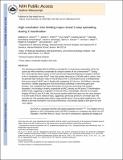| dc.contributor.author | Simon, Matthew D. | en_US |
| dc.contributor.author | Pinter, Stefan F. | en_US |
| dc.contributor.author | Fang, Rui | en_US |
| dc.contributor.author | Sarma, Kavitha | en_US |
| dc.contributor.author | Rutenberg-Schoenberg, Michael | en_US |
| dc.contributor.author | Bowman, Sarah K. | en_US |
| dc.contributor.author | Kesner, Barry A. | en_US |
| dc.contributor.author | Maier, Verena K. | en_US |
| dc.contributor.author | Kingston, Robert E. | en_US |
| dc.contributor.author | Lee, Jeannie T. | en_US |
| dc.date.accessioned | 2014-07-07T17:03:35Z | |
| dc.date.issued | 2014 | en_US |
| dc.identifier.citation | Simon, Matthew D., Stefan F. Pinter, Rui Fang, Kavitha Sarma, Michael Rutenberg-Schoenberg, Sarah K. Bowman, Barry A. Kesner, Verena K. Maier, Robert E. Kingston, and Jeannie T. Lee. 2014. “High-resolution Xist binding maps reveal 2-step spreading during X-inactivation.” Nature 504 (7480): 465-469. doi:10.1038/nature12719. http://dx.doi.org/10.1038/nature12719. | en |
| dc.identifier.issn | 0028-0836 | en |
| dc.identifier.uri | http://nrs.harvard.edu/urn-3:HUL.InstRepos:12406712 | |
| dc.description.abstract | The Xist long noncoding RNA (lncRNA) is essential for X-chromosome inactivation (XCI), the process by which mammals compensate for unequal numbers of sex chromosomes1-3. During XCI, Xist coats the future inactive X (Xi)4 and recruits Polycomb Repressive Complex 2 (PRC2) to the X-inactivation center (Xic)5. How Xist spreads silencing on a 150 Mb scale is unclear. Here we generate high-resolution maps of Xist binding on the X chromosome across a developmental time course using CHART-seq. In female cells undergoing XCI de novo, Xist follows a two-step mechanism, initially targeting gene-rich islands before spreading to intervening gene-poor domains. Xist is depleted from genes that escape XCI but may concentrate near escapee boundaries. Xist binding is linearly proportional to PRC2 density and H3 lysine 27 trimethylation (H3K27me3), suggesting co-migration of Xist and PRC2. Interestingly, when the Xi is acutely stripped off Xist in post-XCI cells, Xist recovers quickly within both gene-rich and -poor domains on a time-scale of hours instead of days, suggesting a previously primed Xi chromatin state. We conclude that Xist spreading takes distinct stage-specific forms: During initial establishment, Xist follows a two-step mechanism, but during maintenance, Xist spreads rapidly to both gene-rich and -poor regions. | en |
| dc.language.iso | en_US | en |
| dc.relation.isversionof | doi:10.1038/nature12719 | en |
| dc.relation.hasversion | http://www.ncbi.nlm.nih.gov/pmc/articles/PMC3904790/pdf/ | en |
| dash.license | LAA | en_US |
| dc.title | High-resolution Xist binding maps reveal 2-step spreading during X-inactivation | en |
| dc.type | Journal Article | en_US |
| dc.description.version | Version of Record | en |
| dc.relation.journal | Nature | en |
| dash.depositing.author | Pinter, Stefan F. | en_US |
| dc.date.available | 2014-07-07T17:03:35Z | |
| dc.identifier.doi | 10.1038/nature12719 | * |
| dash.contributor.affiliated | Kesner, Barry | |
| dash.contributor.affiliated | Maier, Verena K. | |
| dash.contributor.affiliated | Pinter, Stefan F. | |
| dash.contributor.affiliated | Sarma, Kavitha | |
| dash.contributor.affiliated | Bowman, Sarah K. | |
| dash.contributor.affiliated | Lee, Jeannie | |
| dash.contributor.affiliated | Kingston, Robert | |


